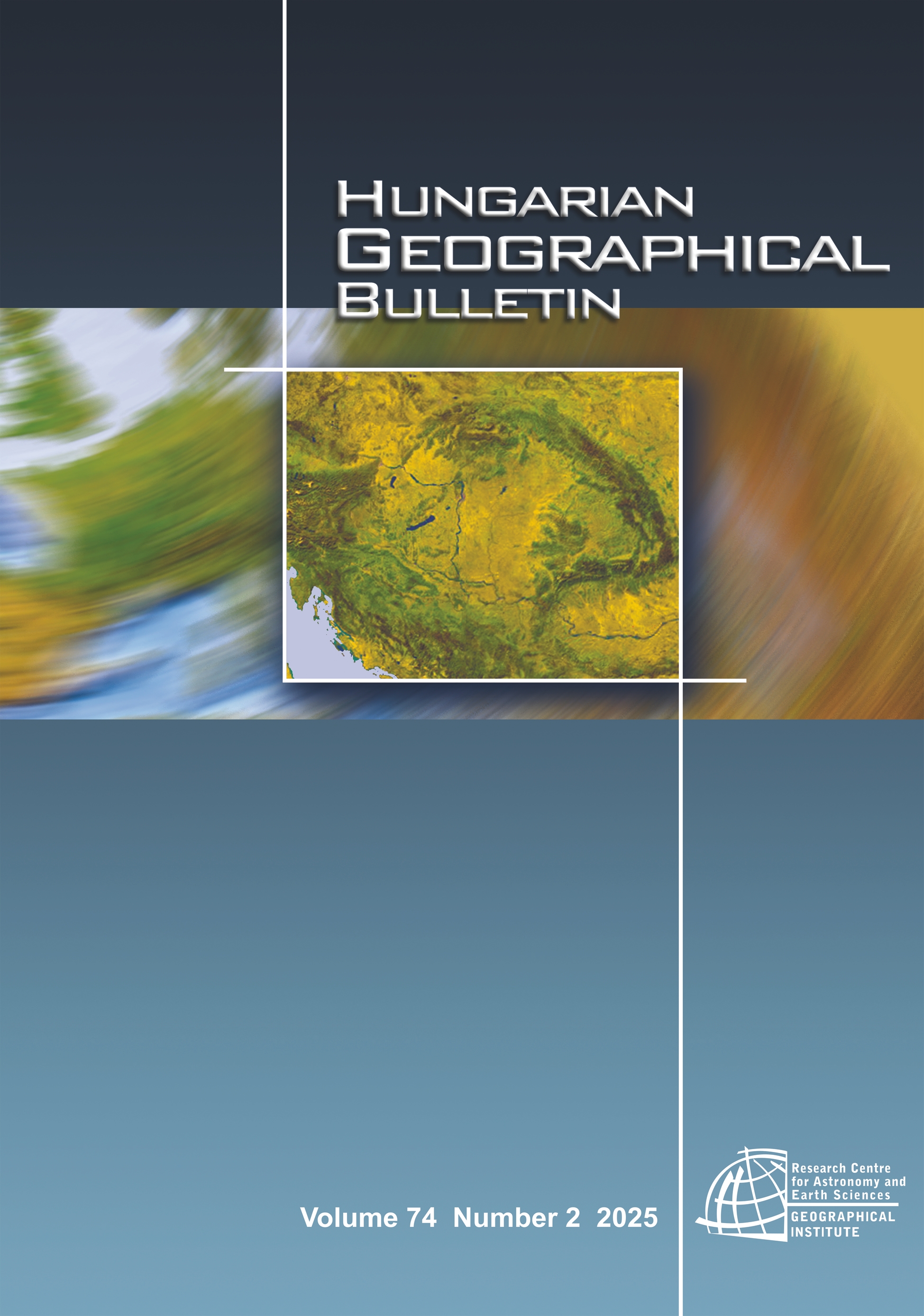Analysis of spatial dependencies and spatial effects in the relationship between economic growth and unemployment in Europe
Abstract
The study presents an analysis of the relationship between unemployment and economic growth in European countries. The significant influence of the labour market situation on the economic condition of states is well-known. The analysis in this research was conducted using data from 43 selected European countries from 2006 to 2019. To evaluate the relationship between economic growth and the unemployment rate, enriched with spatial dependencies, spatial models for pooled time series and cross-sectional data (TSCS) were estimated. The neighbourhood was quantified using three types of connection matrices: (1) based on the common border criterion, (2) based on the maximum distance criterion, and (3) based on the similarity in socio-economic situations. Matrices (1) and (2) relate to the geographical neighbourhood, while matrix (3) defines the economic neighbourhood based on the values of the Human Development Index. The choice of these types of matrices was associated with the migration process (geographical neighbourhood) and the imitation effect of labour market strategies (economic neighbourhood) mentioned above. Based on the estimation and verification results of the Spatial Durbin Models (SDM), the spatial spillover effects were evaluated. Cumulative spatial effects allowed us to determine countries with the greatest influence on others and countries that are following the leading ones.
References
AL-HABEES, M.A. and RUMMAN, M.A. 2012. The relationship between unemployment and economic growth in Jordan and some Arab countries. World Applied Sciences Journal 18. (5): 673–680.
ALHDIY, F.M., JOHARI, F., DAUD, S.N.M. and RAHMAN, A.A. 2015. Short and long term relationship between economic growth and unemployment in Egypt: An empirical analysis. Mediterranean Journal of Social Sciences 6. (4): 454–454. https://doi.org/10.5901/mjss.2015.v6n4s3p454
ANSELIN, L., FLORAX, R.J.G.M. and REY, S. 2004. Advances in Spatial Econometrics. Methodology, Tools and Applications. New York, Springer. https://doi.org/10.1007/978-3-662-05617-2
BALL, L., LEIGH, D. and LOUNGANI, P. 2017. Okun's law: Fit at 50? Journal of Money, Credit and Banking 49. (7): 1413–1441. https://doi.org/10.1111/jmcb.12420
BARRETO, H. and HOWLAND, F. 1993. There are Two Okun's Law Relationships between Output and Unemployment. Crawfordsville, USA, Mimeo, Wabash College.
BASISTHA, A. and KUSCEVIC, C.M.M. 2017. The role of spatial GDP spillovers in state-level Okun’s law. Letters in Spatial and Resource Sciences 10. (3): 353–360. https://doi.org/10.1007/s12076-017-0189-7
BINET, M.E. and FACCHINI, F. 2013. Okun's law in the French regions: A cross-regional comparison. Economics Bulletin 33. (1): 420–433.
CAZES, S., VERICK, S. and AL-HUSSAMI, F. 2011. Diverging trends in unemployment in the United States and Europe: Evidence from Okun’s law and the global financial crisis. Employment Working Papers 106. Geneva, ILO.
ELHORST, J.P. 2011. Spatial panel data models. In Handbook of Applied Spatial Analysis. Eds.: FISCHER, M.M. and GETIS, A., Cham, Springer, 377–407. https://doi.org/10.1007/978-3-642-03647-7_19
ELHORST, J.P. and EMILI, S. 2022. A spatial econometric multivariate model of Okun's law. Regional Science and Urban Economics 93. 103756. https://doi.org/10.1016/j.regsciurbeco.2021.103756
FORMÁNEK, T. and HUŠEK, R. 2016. Spatial aspects of unemployment in the Visegrad-Group economies. Creative and Knowledge Society 6. (2): 1–12. https://doi.org/10.1515/cks-2016-0007
HODRICK, R.J. and PRESCOTT, E.C. 1997. Post-war US business cycles: an empirical investigation. Journal of Money, Credit, and Banking 29. (1): 1–16. https://doi.org/10.2307/2953682
JANKIEWICZ, M. and SZULC, E. 2021. Analysis of spatial effects in the relationship between CO2 emissions and renewable energy consumption in the context of economic growth. Energies 14. (18): 5829. https://doi.org/10.3390/en14185829
JANKIEWICZ, M. 2023. Regional economic growth and unemployment in the European Union: A spatio-temporal analysis at the NUTS-2 level (2013–2019). Hungarian Geographical Bulletin 72. (2): 179–192. https://doi.org/10.15201/hungeobull.72.2.6
LEE, E.S. 1966. A theory of migration. Demography 3. 47–57. https://doi.org/10.2307/2060063
LESAGE, J. and PACE, R.K. 2009. Introduction to Spatial Econometrics. New York, Chapman and Hall/CRC. https://doi.org/10.1201/9781420064254
LI, C.S. and LIU, Z.J. 2012. Study on the relationship among Chinese unemployment rate, economic growth and inflation. Advance in Applied Economics and Finance 1. (1): 1–6.
LOUAIL, B. and RIACHE, S. 2019. Asymmetry relationship between economic growth and unemployment rates in the Saudi economy: Application of Okun’s law during the period. International Journal of Advanced and Applied Sciences 6. (10): 83–88. https://doi.org/10.2478/manment-2019-0070
MADITO, O. and KHUMALO, J. 2014. Economic growth-unemployment nexus in South Africa: VECM approach. Mediterranean Journal of Social Sciences 5. (20): 79–84. https://doi.org/10.5901/mjss.2014.v5n20p79
MAKARINGE, S.C. and KHOBAI, H. 2018. The effect of unemployment on economic growth in South Africa (1994–2016). Working Papers 1815. Gqeberha, South Africa, Department of Economics, Nelson Mandela University. https://mpra.ub.uni-muenchen.de/85305/1/MPRA_paper_85305.pdf
MAZA, A. 2022. Regional differences in Okun’s law and explanatory factors: Some insights from Europe. International Regional Science Review 45. (5): 555–580. https://doi.org/10.1177/01600176221082309
MONTERO KUSCEVIC, C.M. 2014. Okun’s law and urban spillovers in US unemployment. The Annals of Regional Science 53. (3): 719–730. https://doi.org/10.1007/s00168-014-0640-2
MORAN, P.A.P. 1948. The interpretation of statistical maps. Journal of the Royal Statistical Society Series B 10. 243–251. https://doi.org/10.1111/j.2517-6161.1948.tb00012.x
NIKOLLI, E. 2014. Economic growth and unemployment rate. Case of Albania. European Journal of Social Science Education and Research 1. (1): 217–227. https://doi.org/10.26417/ejser.v1i1.p217-227
OBERST, C. and OELGEMÖLLER, J. 2013. Economic growth and regional labour market development in German regions: Okun's law in a spatial context. FCN Working Paper 5. (2013). E.ON Energy Research Center. https://doi.org/10.2139/ssrn.2240260
OKORO-UGOCHUKWU, N.A. and ADENOMON, M.O. 2021. Application of Okun’s law on Nigerian economy: Evidence from spatial econometrics analysis. Science World Journal 16. (3): 291–295.
OKUN, A.M. 1962. Potential GNP: Its measurement and significance. In Proceedings of the Business and Economics Section. Boston, American Statistical Association, 98–103.
ONAKOYA, A.B. and SEYINGBO, A.V. 2020. Economic growth and unemployment nexus: Okun’s two-version case for Nigeria, South Africa, and United States of America. Journal of Economics and Behavioral Studies 12. (1): 55–65. https://doi.org/10.22610/jebs.v12i1(J).3006
PALOMBI, S., PERMAN, R. and TAVÉRA, C. 2015. Regional growth and unemployment in the medium run: Asymmetric co-integrated Okun’s law for UK regions. Applied Economics 47. (57): 6228–6238. https://doi.org/10.1080/00036846.2015.1068922
PALOMBI, S., PERMAN, R. and TAVÉRA, C. 2017. Commuting effects in Okun's law among British areas: Evidence from spatial panel econometrics. Papers in Regional Science 96. (1): 191–209. https://doi.org/10.1111/pirs.12166
PEREIRA, R.M. 2014. Okun’s law, asymmetries and regional spillovers: Evidence from Virginia metropolitan statistical areas and the District of Columbia. The Annals of Regional Science 52. (2): 583–595. https://doi.org/10.1007/s00168-014-0600-x
SADIKU, M., IBRAHIMI, A. and SADIKU, L. 2015. Econometric estimation of the relationship between unemployment rate and economic growth of FYR of Macedonia. Procedia Economics and Finance 19. 69–81. https://doi.org/10.1016/S2212-5671(15)00009-X
SALVATI, L. 2015. Space matters: Reconstructing a local-scale Okun's law for Italy. International Journal of Finance, Insurance and Risk Management 5. (1): 833–840.
SCHABENBERGER, O. and GOTWAY, C.A. 2005. Statistical Methods for Spatial Data Analysis. Boca Raton–London–New York, Champion & Hall/CRC.
SOYLU, Ö.B., ÇAKMAK, İ. and OKUR, F. 2018. Economic growth and unemployment issue: Panel data analysis in Eastern European countries. Journal of International Studies 11. (1): 93–107. https://doi.org/10.14254/2071-8330.2018/11-1/7
SZULC, E. and JANKIEWICZ, M. 2018. Spatio‑temporal modelling of the influence of the number of business entities in selected urban centres on unemployment in the Kujawsko‑Pomorskie voivodeship. Acta Universitatis Lodziensis. Folia Oeconomica 4. (337): 21–37. https://doi.org/10.18778/0208-6018.337.02
TOBLER, W.R. 1970. A computer movie simulating urban growth in the Detroit region. Economic Geography 46. (Supplement 1): 234–240. https://doi.org/10.2307/143141
VALADKHANI, A. and SMYTH, R. 2015. Switching and asymmetric behaviour of the Okun coefficient in the US: Evidence for the 1948–2015 period. Economic Modelling 50. 281–290. https://doi.org/10.1016/j.econmod.2015.07.001
VEGA, S.H. and ELHORST, J.P. 2013. On spatial econometric models, spillover effects, and W. In 53rd ERSA Congress "Regional Integration: Europe, the Mediterranean and the World Economy", 27–31 August 2013. Palermo, Italy. Louvain-la-Neuve, ERSA, 1–13.
VILLAVERDE, J. and MAZA, A. 2016. Okun’s law among Spanish regions: A spatial panel approach. XLI Reunión de Estudios Regionales, Reus.
XU, B., YU, H. and LI, L. 2021. The impact of entrepreneurship on regional economic growth: A perspective of spatial heterogeneity. Entrepreneurship & Regional Development 33. (3–4): 309–331. https://doi.org/10.1080/08985626.2021.1872940
Copyright (c) 2025 Mateusz Jankiewicz

This work is licensed under a Creative Commons Attribution-NonCommercial-NoDerivatives 4.0 International License.






